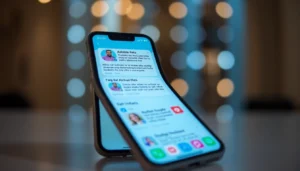
Introduction to the DILF Term: Origins and Meaning
The term dilf is a colloquial acronym that stands for “Dad/Daddy I’d Like to F*.” It has gained significant popularity in modern slang, especially within internet culture, social media, and pop culture. Unlike other terms that focus solely on age or parental status, dilf is primarily used to describe an older, mature man who exudes attractiveness and sexual appeal, regardless of whether he is actually a father. This term emerged shortly after the rise of its sister term, MILF, which gained widespread recognition through movies, television, and internet culture. While MILF specifically refers to attractive mothers, DILF broadens the scope to include older men who possess a certain charm, confidence, and appeal that make them desirable.
The word originated in informal conversations, memes, and online communities before entering mainstream media and pop culture. Its humorous, provocative nature allows it to be used both as a compliment and in jest. The appeal of DILFs lies in the societal admiration of older men who maintain youthful attractiveness, confidence, and a sense of style. As societal attitudes towards aging and masculinity evolve, the idea of the DILF has become a symbol of attractiveness that defies traditional age boundaries, celebrating mature masculinity and charisma.
How DILFs Are Portrayed in Popular Culture
Film and TV Examples
The portrayal of DILFs in film and television has significantly contributed to the term’s popularity and normalization. One notable example is the 2009 movie American Pie Presents: The Book of Love. This installment of the American Pie franchise introduces a character who fits the classic DILF archetype: Rob’s father. Portrayed as a confident, attractive, and charismatic older man, he embodies many traits associated with the DILF label—maturity paired with a youthful appeal. The film used this character to inject humor and to challenge traditional notions of attractiveness, emphasizing that age is just a number when it comes to desirability.
Another prominent example comes from the popular television series Riverdale. Since its debut in 2017, Riverdale has been known for its edgy storytelling and attractive cast. One character, Fred Andrews, played by Luke Perry, is widely regarded by fans as a DILF. His role as a caring father combined with his rugged good looks and mature demeanor made him a fan favorite. The character’s portrayal as a strong, protective, and attractive older man helped reinforce the cultural image of the DILF as a desirable figure within media narratives.
Video Game Characters
The influence of DILFs extends beyond traditional media into video games, where character design often emphasizes attractiveness and charisma. An excellent example is Daddy Halsin from the popular role-playing game Baldur’s Gate III. Fans and players have nicknamed him “Daddy Halsin” due to his protective, strong, and commanding personality, combined with his mature, handsome appearance. While he is a non-playable character meant to portray a druid leader, the sheer popularity and affection from fans have elevated his status as a DILF figure in gaming culture. This phenomenon illustrates how the archetype of the attractive, authoritative older man resonates across various entertainment platforms, including interactive media.
The Internet and Social Media Trends
The DILFs of Disneyland Instagram Phenomenon
One of the most fascinating modern expressions of the DILF phenomenon is the rise of the DILF meme on social platforms. Instagram accounts like “DILFs of Disneyland” have amassed over 300,000 followers, showcasing photos of attractive older men spending family time at Disneyland and similar family-friendly venues. These images often feature fathers or father-figures displaying confidence, style, and charm, challenging traditional notions of masculinity and attractiveness. The account’s popularity underscores how society increasingly celebrates mature masculinity and how the term DILF has become a badge of honor, often used humorously or affectionately.
This online phenomenon reflects broader cultural shifts emphasizing the appeal of older men who maintain youthful vigor and style. It also highlights how social media fosters communities that appreciate and normalize the attractiveness of mature men, blurring the lines between traditional age-related stereotypes and contemporary standards of desirability.
Reddit Communities and Online Discussions
Another vital aspect of the DILF culture is its presence in online forums, particularly Reddit. The subreddit r/DILFs, which boasts close to 100,000 members, serves as a dedicated space for fans and enthusiasts to share photos, discuss their admiration for attractive older men, and celebrate masculinity at any age. This community exemplifies the casual yet enthusiastic embrace of the DILF label, often blending humor with genuine admiration.
Discussions on Reddit frequently touch on the appeal of older men who embody confidence, style, and strength—traits that align with traditional masculinity but are increasingly appreciated regardless of age. The community also explores the broader cultural implications of the term, including how media representation influences societal attitudes towards aging and attractiveness.
DILF in Pornography and Search Trends
The popularity of the dilf archetype has profoundly impacted adult entertainment and online search behaviors. As society’s appreciation for mature masculinity grows, so does the demand for content featuring older, attractive men. The term “DILF” has become a widely searched keyword and tag within the adult industry, with many producers creating dedicated content to cater to this audience.
Data from various adult content platforms indicate a steady increase in searches for DILF-related videos and images, reflecting a broader cultural acceptance and celebration of older men as desirable figures. This trend not only signifies changing beauty standards but also highlights a shift toward recognizing the attractiveness of maturity and confidence over youthfulness alone.
The Cultural Shift: Why Attractive Older Men Are Celebrated
The rise of the DILF phenomenon aligns with evolving societal attitudes towards aging, masculinity, and attractiveness. Historically, media and popular culture have prioritized youth, often marginalizing older men as less desirable. However, recent trends demonstrate a growing appreciation for mature masculinity, which emphasizes confidence, life experience, and charisma.
Several factors contribute to this cultural shift. First, increased longevity and better health allow older men to maintain a youthful appearance and active lifestyle, making them more appealing. Second, societal norms are increasingly accepting of diverse expressions of masculinity, moving beyond stereotypical images of the rugged, young male hero. Third, the rise of social media empowers older men to showcase their style, fitness, and confidence, challenging ageist stereotypes and inspiring admiration.
This cultural movement also reflects a broader acceptance of aging as a natural, beautiful process. Celebrating attractive older men through the DILF archetype symbolizes a rejection of age discrimination and promotes a more inclusive view of attractiveness that values maturity and life experience.
Conclusion: The Future of DILF Representation in Media and Culture / The Rise of the DILF: Exploring the Cultural and Media Portrayal of Attractive Older Men
The term dilf has evolved from a humorous slang to a significant cultural symbol representing societal shifts in perceptions of attractiveness and masculinity. From its origins in informal language to its portrayal in movies, television, video games, and social media, the DILF archetype has gained recognition and admiration across various platforms.
Popular culture continues to embrace the idea that attractiveness is not confined to youth, and older men can embody confidence, strength, and style that make them desirable. The internet’s role in promoting the DILF phenomenon—through Instagram accounts, Reddit communities, and search trends—further cements its place in contemporary culture. As societal attitudes towards aging continue to evolve, we can expect the representation of DILFs to become even more diverse and normalized.
Looking ahead, the future of DILF representation in media appears promising. More inclusive and varied portrayals of masculinity are likely to emerge, celebrating the appeal of mature men in both mainstream entertainment and niche communities alike. This shift not only reflects changing beauty standards but also promotes a healthier, more accepting view of aging and attractiveness.
In conclusion, the rise of the dilf archetype exemplifies a broader cultural movement that values confidence, charisma, and maturity as essential components of attractiveness. Whether humorously referenced in memes or seriously celebrated in media, DILFs symbolize a more inclusive understanding of beauty that transcends age and emphasizes personality and style.



